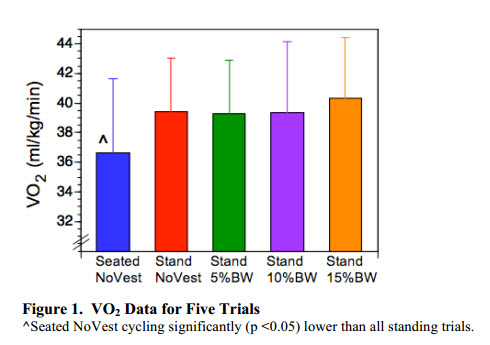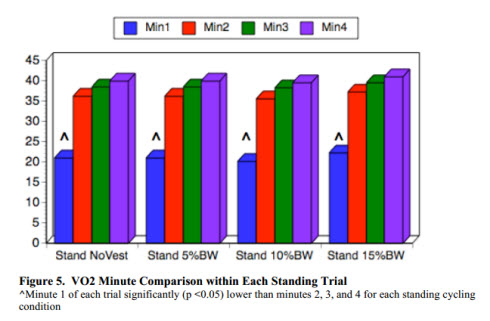
The increase was a 67 to 76% increase in energy expenditure for all standing cycling
conditions. Image from the study.
New research sponsored by ACE demonstrates that standing (vs. sitting) burns more calories, as long as you keep everyone out of the saddle long enough. This study was conducted by a team lead by Dr. Len Kravitz at the University of New Mexico.[wlm_private 'PRO-Platinum|PRO-Monthly|PRO-Gratis|PRO-Seasonal|Platinum-trial|Monthly-trial|PRO-Military|30-Days-of-PRO|90 Day PRO|Stages-Instructor|Schwinn-Instructor|Instructor-Bonus|28 Day Challenge']
The study you can download here; Metabolic Cost of Weighted Vests During Standing Cycling was designed to look at the effect of adding additional weight (with a weighted backpack) to an Indoor Cyclist and learn the metabolic affect from how long you're out of the saddle:
Abstract
Whether cycling on the road or pedaling in a club cycle class, this mode of activity is done using
both seated or standing positions. Previous research has examined the effect that cycling position
exerts on physiologic parameters such as heart rate (HR), oxygen consumption (VO2), or rating
of perceived exertion (RPE) during exercise (1—3). This research was intended to simulate hill
climbing, which is applicable to a majority of road cyclists. However, no prior research has
examined the effect of wearing a weighted vest during stationary standing cycling. As well, no
research has investigated the effect of extended bouts of stationary standing cycling (1, 2, 3 and
4 minutes) on metabolic parameters. The implications for this research may directly impact
individuals engaged in fitness center stationary cycling classes, which have become very popular
in recent years.
Anything to burn more calories
I met Dr. Kravitz in the Fall of 2012 at a fitness conference. Once he learned my interest in Indoor Cycling, he excitedly told me about his idea to study the potential training and calorie expenditure effects of adding weight to an Indoor Cyclist. If I'm remembering correctly, he expressed the understanding that weight loss / weight management is high on the list of reasons our riders come to class. If strapping on a backpack full of bricks was going to help someone reach their goal weight, I was all for learning more - and then share it with you.
Based on the chart above, it doesn't appear that adding weight has nearly the affect that simply getting everyone out of the saddle does.
The first minute is just practice
The biggest take-away from this study for me, was the huge jump in calorie expenditure that occurs beyond the first minute.

Will seeing this change how you structure time out of the saddle?
Energy expenditure stabilized between minute 3 and 4 on all standing cycling conditions. This information provides program design suggestions for personal trainers and club cycle instructors desiring to optimize caloric expenditure utilizing research-driven methodology. Clearly, the inclusion of standing cycling bouts for 2 to 3 minutes during a cycling bout meaningfully increases energy expenditure. This increase in oxygen demand occurs during standing, with or
without a weighted vest (up to 15%BW was used in this study). According to Tanaka et al (3), this energy expenditure increase is attributable to the increased muscle blood flow and/or involvement of a larger muscle mass with standing cycling.
[/wlm_private]Dr. Kravitz's team has done a number of other studies that you may find of interest. I interviewed Doctoral student Micah Zuhl in 2012 and discussed the article he co-wrote with Dr. Len Kravitz entitled HIIT vs. Continuous Endurance Training: Battle of the Aerobic Titans. ICI/PRO Podcast #201 — HIIT vs Endurance Training with Micah Zuhl
Originally posted 2013-11-10 09:00:43.

My challenge with standing comes from the inevitable cadence sacrifice that occurs.
As a tour rider, I use standing as a tool to introduce an increased gear, but remain in saddle for long as possible for optimal power output…your thoughts?
I completely agree Ryan, outdoors the need to be as efficient as possible make perfect sense.
Understanding that most people come to our classes to burn calories, I think there are times indoors we need to flip that thinking on it’s head = be less efficient, which can result in burning more energy, over the length of a class.
I have a tentative interview set with Dr. Kravitz for next month. The plan will be to discuss all of this in more detail 🙂
I’ve taken a number of classes in which we logged most of our time standing. Ryan’s comment about decreased cadence seems true, based on my observation of my own pedaling and that of others in the class.
More importantly, a class spent mostly standing leaves me feeling as if my muscles have done nothing, regardless of the heart rates I’ve attained or how I’ve pushed to keep up the cadence. When I hear participants and instructors alike mention that their heart rates drop whenever they climb seated, it strikes me as anecdotal evidence that their legs can’t generate the power to attain higher heart rates from the saddle. Years of training in Jim Karanas’s Performance Max program convinced me that standing climbs don’t strengthen the legs as well as seated ones.
What do you guys think?
Joan I think this is one of those perception vs. reality things. Standing = higher HR’s = I must be working harder is the perception of many, even if the reality is that you’re not actually getting fitter/stronger.
That said, a high percentage of our athletes are just there to burn calories. This research is saying they are, especially after the first minute.
I agree with you, John, and do understand the data from Len Kravitz’s research. I’ve known Len for years and think he’s wonderful, but his study was a comparison of two cycling workouts — one done mostly standing and one done mostly seated. I would find a somewhat different study interesting — a comparison between two groups, one that trains mostly standing and the other that grinds out seated strength work and works a lot with seated power work, as well. If those two groups were put into a seated training together, which one would burn more calories? If they were put into a standing training, which group would burn more calories? I’m still of the opinion that the stronger we can make cycling participants, and the more power they can generate, the more calories they can burn because their legs can take it. But I can’t say that definitively without a study run along those lines.
I observed the class I took this morning even more carefully in light of having read your post beforehand. Everyone’s legs slowed to offset the work (including the instructor’s) when standing, whether we were climbing or not. This was true even though he told the class to match the beat, although I wouldn’t consider this guy competent at teaching beat-match. (For the record, I stayed in the saddle, then worked like crazy to get my HR high, just to be a contrarian. But that’s me.)
Anyway, just my opinion.